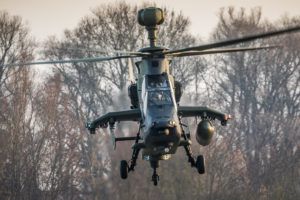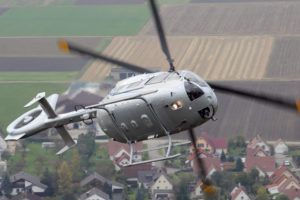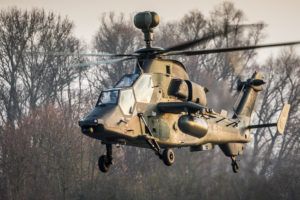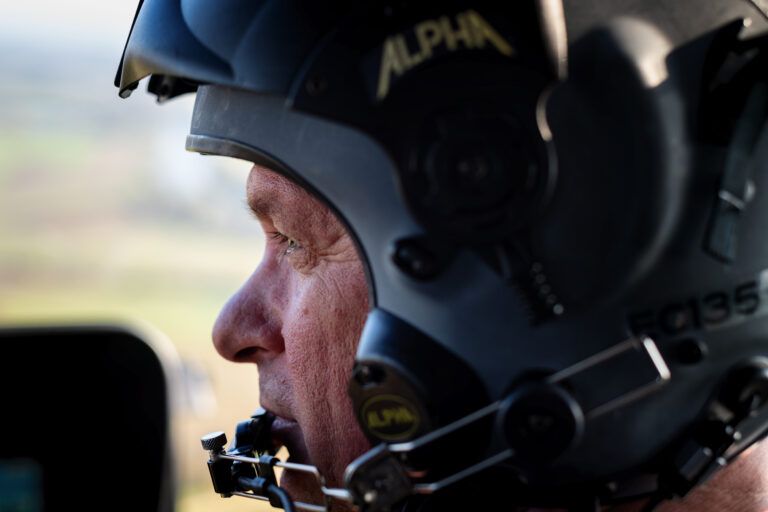Volker Bau, chief test pilot at Airbus Helicopters discusses his career and the demands the modern day test pilot faces.
Volker Bau is based at Donauwörth, Germany and is responsible for helicopter testing operations at Airbus’ testing stations throughout Germany. Bau has been a test pilot for 20 years, training at Boscombe Down in 2001. He joined Airbus in 2006 and has been the chief test pilot since 2010. He has flown more than 60 different types of aircraft, both fixed wing and helicopter.
What program are you working on?
At the moment I’m working on a weapons integration project on the civilian H145M. The team has installed
a weapon on the aircraft and has integrated the software and then we shoot it on a test range.
It’s an unusual program. In the past I’ve done similar things on a Tiger helicopter for military projects, with military systems at shooting ranges. But in this program we have a civil-registered aircraft and we are flying in civilian airspace, so getting the permissions for the testing is a challenge. The laws are not there so we have to define them.
What type of programs do you usually do?
I work on a mix of 50/50 civilian and military projects. At Donauwörth we have a Tiger and a CH-53 and civilian aircraft like the H135 and H145. Even then we can have a H145 with a military registration.
What is your typical day?
A typical program has two pilots, a project pilot and a deputy. I get to fly almost every day. A day always starts with the team briefing. We receive the weather information, the NOTAMs, we get the status of the aircraft and a project update and decide who is doing what work.
Then there is paperwork to do before, we fly the mission and then we do the debriefing. They are quite long days!
What is most challenging about being a test pilot?
The teamwork can be challenging. I am flying and testing the weapon but there is a team of at least ten around you, weapon experts, engineering experts, software experts. They are all observing you remotely.
They are sitting in telemetry, but they are also on board with cameras and voice comms. They can see exactly which button you press and which stick you pull – they often see your mistakes before you do!
What has been the highlight of your career so far?
It’s probably the first flights, of which I’ve flown three. The most important and most challenging was the first flight of the H145. It had a new Fenestron and a modified rotor, transmissions and engines.
I was part of the H145 program from the start until it was in the hands of customers. It was both a positive and negative experience!
Tell me more about that program?
With programs where you are developing aircraft the test pilot must push the aircraft’s performance envelope. So, for example if you are looking at engine performance you have to switch off an engine and land at maybe 100ft (30m). If you manage to do it, the engineers put 100kg more on the aircraft. And they will keep on doing that for as long as you are not destroying the aircraft.

Are there any other flight test programs you can highlight?
I was really impressed by our autonomous flight systems test program which I was involved in. We flew an EC145 without the pilot. At the start I wasn’t very happy to be chosen for the project, but it was very challenging. It turned out to be very interesting.
How did you become a test pilot?
My flying career started the same way many others do – at a glider club when I was 14 years old. I kept on flying gliders, then small aircraft and moved on to helicopters with the German Army Aviation Corps.
I became very interested in technical flying and there was an opportunity to go the military test pilot school, which I took.
How did you find your job at first?
Normally when you attend university and get a technical masters, a lot of engineers and pilots will not use all
of that knowledge in their career. But I quickly learnt that as a test pilot you must use that knowledge
every day.
How does a test pilot influence an aircraft’s development?

You have a huge influence on the aircraft. You must answer a lot of requirements and ensure the aircraft is safe. But you also influence the design, particularly aspects of it like the man-machine interface.
For example, after flying one day in a debriefing for the H145 we were discussing how to develop the engine control panel. An idea occurred to me and I sketched it on a napkin. One of the engineers took this and in a couple of days had created a mock-up from it.
Now that is exactly the engine control panel in every H145. It is very satisfying to see that direct influence.
It doesn’t always work that directly, but when it does
it’s great.
What else do you find satisfying about your job?
We build and design aircraft for our customers. If the customer is happy it is satisfying. If you see the H145 fulfil a mission well, for example as medical evac it is great. To see that helicopter land on the highway and rescue someone from an accident is more than satisfying.
Can you describe your approach to risk?
This job is definitely very risky, you cannot escape that. When I try to get life insurance, no one will take me!
However, we work in a team and before every flight in the briefing we discuss the risks. Flights can get routine, but we do it every time. Once we have identified the risks, we try and mitigate them.
For example if we are doing an auto-rotation we train for it before on an easier aircraft. But there is always a little bit of an unknown, especially when flying a new aircraft.
Is the unknown factor exciting to test pilots?
For me personally no. I’m not looking for risks, I’m more interested in technical solutions. Yes, you must have risk if you are flight testing, but only because it is necessary. I’m not a risk-taking person.

How do you think being a test pilot will change?
There are changes happening because of software. One upgrade can change the aircraft completely, the engine behavior, the flight controls, everything. But the basic test pilot’s work will always be the same. We will always need test pilots and need more now. In our company there is ten test pilots and the average age is above 50. So, in the next ten years we will need ten new test pilots.
What advice would you give to an aspiring test pilot?
It is difficult to become a test pilot. You need the right operational background. You have to be the right man in the right place at the right time.
You must focus on your target without compromise. I had the chance when I was young to work on the flight testing of a small ultralight aircraft. I learnt how to work as part of a team – I realized early on that as the pilot you are only a small part of the puzzle. It’s a good lesson that prepared me for my career.
What is your favorite aircraft to fly?
In my spare time I fly vintage aircraft and one of my favorite to fly is the Messerschmitt. The experience is similar in lots of ways to helicopter testing – you do your training and preparation – including the operational limits and a risk assessment. Then you sit in the machine, except it is a very old machine. You have to be more careful, there are more things that can go wrong.






